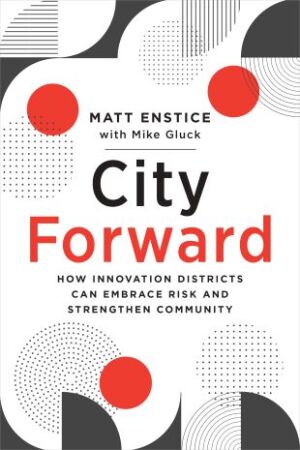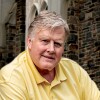Leading an innovation district in a legacy city like Buffalo is quite a challenge. Matt Enstice, president and CEO of Buffalo Niagara Medical Campus (BNMC) lets us in on his strategies—warts and all—in his new book, City Forward(2022, Island Press).
BNMC didn’t start out as an innovation district, and Enstice didn’t start out as an urban developer. (Maybe that’s the most important lesson from Enstice’s book: It’s critical to recognize good opportunities and do what it takes to capitalize on them.)
Buffalo’s mayor in 2000, Tony Masiello, wanted the major players in the area just north of Downtown and east of Main Street to talk to one another and compare notes. Let’s call it planning collaboratively. And he wanted them to do it in consultation with city, county, and state officials and, perhaps more importantly, directly involving the primarily African-American Fruit Belt neighborhood to the east and the gritty but trendy Allentown district to the west.
The players—Kaleida Health, Roswell Park Cancer Center, the University of Buffalo’s School of Medicine and Biomedical Sciences, and four other health-sciences-related entities—were wary of each other. Leadership at least two of the major players at first rejected the notion of working with recalcitrant neighborhoods.
Thanks to a mayor who insisted that everyone work together and a nonprofit—the John R. Oishei Foundation—that backed him with a sizable challenge grant, BNMC was off and running.
The original purpose of BNMC was to serve as an anchor district, similar to those in areas around universities, museums, hospitals, and other anchor institutions throughout America. The idea is that anchor institutions are unlikely to move, so they must organize to improve the area around it.
Enstice, who prior to returning to Western New York served as executive assistant to Lorne Michaels, producer of NBC’s Saturday Night Live, has used his creative moxie over the past two decades to take the BNMC organization to levels far beyond that of an anchor district—to those of an innovation district. An innovation district is described as an anchor district “plus,” the plus including encouraging and incentivizing an environment to attract related firms, entrepreneurs, and spinoff companies.
Enstice has been savvy about attracting excellent board leadership, motivated staff, supportive (in general) public officials, and strong neighborhood leadership, especially in the form of entrepreneurial African-American clergy. Relations between BNMC and surrounding neighborhoods are far from perfect, but the organization provides a vehicle for consultation and negotiation.
And he has been unafraid to experiment with leading or participating in various programs beyond the usual “clean, safe, and friendly” district initiatives, addressing:
- Parking and transportation—e.g., the ITS4US complete trip deployment program, for which the U.S. Department of Transportation selected BNMC as one of five national pilot programs to develop an integrated suite of travel services that enables older adults and individuals with disabilities to make assisted, connected, and integrated trips without the need for a personal automobile to and from the medical campus.
- Health and wellness--e.g., BNMC Fresh: Farm to Hospital program, an initiative to bring more locally grown and sourced produce, proteins, and other menu items to patients, employees, and visitors across the medical campus.
- Entrepreneurship and innovation—e.g., the EforAll and EForever program, which provide training and mentoring for minority entrepreneurs; EforAll’s free business accelerator program’s 2022 enrolees were 74 percent women, 58 percent persons of color, and 46 percent immigrants .
The net result, in a sluggish Upstate New York economy, has been astounding: the 120-acre (48.6 ha) campus has experienced $1.4 billion in public and private investment in infrastructure; an increase from 4.5 to 9.0 million square feet (418,064 to 836,127 sq m) of office, medical, and health-care facilities; an increase from 6,000 to 16,000 employees; and 300 new business incubated.
Some have argued that, regardless of BNMC, the hospitals would have merged and relocated to the medical-campus area and the university might have relocated its medical school. But the formation of BNMC gave officials, including federal and state funders, confidence that the major institutions were working together to make the area succeed.
(Note: The medical campus lies just 12 blocks from the Tops Market that was the site of the May 12 mass shooting that killed 10 people. Among other gestures, BNMC coordinated outreach of campus entities to the neighborhood, helping to coordinate a large memorial service.)
The Urban Land Institute, in its 2022 report, Legacy Cities: From Rust to Revitalization, cited Buffalo as a model and BNMC as a driver: “…[T]he organization created a bold vision for a new 120-acre campus in downtown—a goal far beyond what most thought possible. The group persevered despite much skepticism from others in the community.”
While BNMC, organized from 2000 to 2002, is perhaps the most significant, it is not the only keystone initiative undertaken in Western New York over the past two decades. The Western New York community has called upon ULI advisory services panels to provide leadership for five other major developments. In every case, the panels have recommended the same integrative approach fostered by BNMC.
- H. Richardson Complex (2007)—redeveloping an historic H.H. Richardson-designed former psychiatric hospital campus into a mixed-use development, including a luxury hotel.
- Millard Fillmore Gates Circle (2011)—redeveloping a former hospital campus, closed and merged with a hospital at BNMC, into a community-serving mixed-use development.
- Niagara Falls, New York (2012)—reimagining the former Rainbow Center shopping mall as one means of revitalizing a struggling downtown.
- One HSBC Center (2013)—filling the once-empty tallest office building in Upstate New York with a variety of uses, including housing.
- Central Terminal (2017)—enlivening the huge, long-vacant former railroad terminal on Buffalo’s East Side.
In two of the cases—Richardson Complex and Central Terminal—not-for-profit corporations not totally unlike BNMC have been formed to fulfill similar functions.
The future of BNMC appears promising. In March, the U.S. Department of Veterans Affairs unveiled plans to build a new $1 billion veterans hospital on or adjacent to the medical campus.
Learn more about ULI’s work with U.S. Legacy Cities.
RICK REINHARD is principal of Niagara Consulting Group in Rockville, Maryland. He spent 13 years in Western New York, leading Downtown Buffalo’s business improvement district, serving as Chief of Staff to the Mayor, teaching urban planning at the University at Buffalo, and assisting the Mayor with early meetings and research to form Buffalo Niagara Medical Campus.






